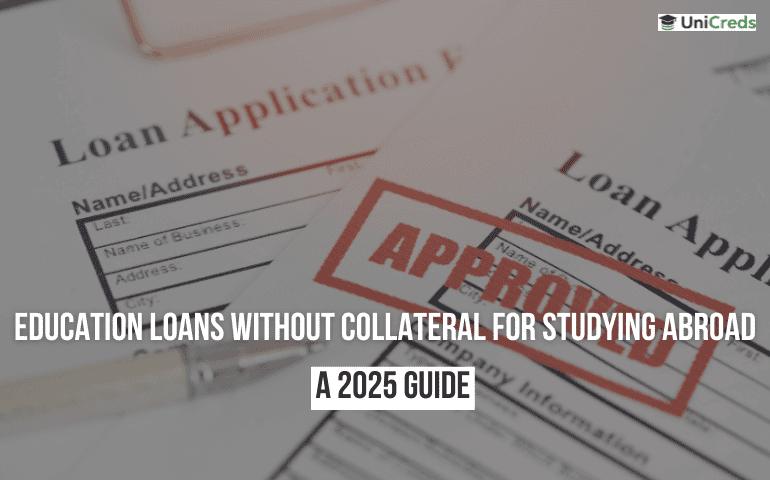Table of Contents
This article addresses queries about the moratorium period, emphasising its significance in the abroad education loan process, particularly with government banks. For those unfamiliar, a moratorium period is a phase in loan repayment where students are not obligated to pay EMIs.
It spans the course duration plus 6-12 months. While public-sector banks allow a payment hiatus, private lenders may require partial or full interest payment.
Before delving into the moratorium period for education loans, let’s briefly explore the various types of education loans in India for higher education, relevant to understanding this concept.
| Moratorium Period In Education Loan | |
| What is a Moratorium Period in Education Loan | A break in loan repayment where students are not obligated to pay EMIs, typically spanning the course duration plus 6-12 months. |
| Interest Charged in Moratorium Period | Interest accumulates during the moratorium, adding to the burden; repayment options include simple interest, partial simple interest, and EMIs. |
| Benefits of Moratorium Period in Education Loan | Eased monthly EMI payments, unaffected credit score, and penalty-free non-payment offer financial flexibility to students. |
| Moratorium Period in Private Banks and NBFCs | Similar to public banks, but private institutions may require full or partial interest payment during the moratorium period. |
| Importance of an Education Loan Calculator | A financial tool helping borrowers estimate the impact of the moratorium on their loan, aiding in financial planning post-moratorium. |
What Is Moratorium Period In Education Loan?
In the simplest words, a moratorium period meaning in education loan is a break in the repayment period of the loan by the borrower to the lender.
What this means is that students do not have to start their education loan repayment immediately after the disbursement of funds from lenders. Thanks to the moratorium periods, students can begin their interest and EMI repayments after they have completed their course successfully.
In addition to this, students can avail an extension of six more months of this education loan moratorium period if they are unable to find employment post their course period. This provides students with some much needed breathing space, as education loan repayments come with a lot of stress and worry.
Is Interest charged In Moratorium Period In Education Loan?
During the moratorium period, students aren’t required to pay EMIs, but the interest keeps accumulating, adding to the overall burden. Hence, starting repayment early reduces the total education loan interest during the moratorium period. Different borrowers have varied perspectives on loan repayment, so banks offer several options:
Simple Interest: Here, the student pays only the simple interest during the study period. The EMI comprises only the principal amount plus compound interest, as simple interest doesn’t add to the principal.
Partial Simple Interest: In this option, the student pays a portion of the simple interest, and the remaining interest is added to the principal. Consequently, compound interest is charged on both the principal and the remaining simple interest.
EMI: With this option, students aren’t obliged to pay any amount until the moratorium period ends. Loan repayments occur through EMIs, and compound interest is levied on the principal amount along with the simple interest.
Example Of How A Moratorium Period in Education Loan Works
To understand the concept and purpose of a moratorium period, let’s consider an illustrative example that highlights its general application.
Suppose ‘A’ obtained a loan of $500,000 from XYZ Bank in January 2024 to expand their business. ‘A’ agreed to make fixed monthly installments of $100,000 over a span of 6 months as a condition to secure the loan. The first payment was scheduled for February 2024, with subsequent payments due at the beginning of each following month.
Unfortunately, in mid-March 2024, ‘A’ faced unforeseen circumstances that forced the closure of their business. Recognising the situation, XYZ Bank offered ‘A’ a moratorium period from mid-March 2024 until June 2024, without any additional charges. As a result, ‘A’ can defer their payment, which was originally due from April 2022 to July 2024.
How Does The Moratorium Period Differ From The Grace Period?
Many students often mix up the moratorium period in education loans with the grace period. The grace period is a time frame without interest, allowing the student several days to pay before the lender starts charging interest on the balance for that month without penalties. During the grace period, the borrower is expected to make the payment. In contrast, during the moratorium period, the student is not required to make any payments. The moratorium period for education loans typically spans the course duration plus 6 months or 1 year.
Benefits Of Moratorium Period in Education Loan
Before Moratorium Periods were even a thing, banks would start asking students to repay their education loans as soon as their course ended without even having a job in hand. This led to a lot of student debt accumulation and as a result, students were forced to take up a part-time job in an effort to pay off their loans.
- Eased Monthly EMI Payments: Students benefit from relaxed monthly EMIs during the moratorium period, typically covering the course duration plus an additional 6 months, extending up to 1 year. Consequently, students are exempt from EMI payments during this period, providing a one-year break from financial obligations resulting into education loan defaulter
- Credit Score Unaffected: The student’s credit score remains unaffected, and timely loan repayments can even contribute to building a positive CIBIL score
- Penalty-Free Non-Payment: No penalties are imposed by the bank for non-payment during the moratorium period, offering students financial flexibility without additional charges
Moratorium Period In Private Banks And NBFCs
In private banks and Non-Banking Financial Companies (NBFCs), the moratorium period operates similarly but with some distinctions. During this period, students are still relieved from making regular Equated Monthly Installments (EMIs), but there are variations in the treatment of interest.
- Full Interest Payment: Some private banks and NBFCs may require students to pay the full interest accrued during the moratorium period. This means that while the principal repayment is deferred, the interest continues to accumulate and must be paid in entirety once the moratorium period concludes.
- Partial Interest Payment: Other lenders might mandate partial interest payment during the moratorium period. In this scenario, students are obligated to pay a portion of the interest, reducing the burden but still incurring some cost.
It’s crucial for borrowers to carefully review and understand the terms set by private banks and NBFCs regarding the moratorium period to make informed decisions about their repayment strategy.
What Is The Moratorium Period Offered By Different Lenders In India?
The moratorium period varies among different types of lenders and can even differ within the same category. Here are the moratorium periods offered by different lenders:
Public-sector Banks: Typically, the moratorium period in government banks is equal to the course duration plus 6 months. During this period, students are not required to make any payments.
Private-sector Banks: In private banks, the moratorium period is generally equal to the course duration plus 12 months. However, the borrower is expected to pay a simple interest amount during the moratorium period. The repayment of installments, including a portion of the principal amount, begins after the moratorium period.
NBFCs: Generally, the moratorium period in NBFCs is equal to the course duration plus 12 months. Similar to private banks, the borrower is usually required to pay a simple interest amount or a partial interest (determined and communicated during the loan application process) during this moratorium period. The repayment of installments, which includes a portion of the principal amount, starts after the moratorium period.
Why Is The Moratorium Period Important In Student Loans?
The moratorium period, as per banking regulations, ensures that individuals who do not make repayments during this period are not classified as loan defaulters. During the moratorium period, simple interest is computed solely on the disbursed amount, excluding margin money.
A considerable number of Indian students pursue higher studies abroad and often rely on education loans for financial support. To allow these students a period of undisturbed study and job search, providing a moratorium period on education loans is crucial.
Importance Of An Education Loan Calculator With Moratorium Period
An education loan calculator or repayment calculator during the moratorium period is a financial tool that helps borrowers estimate the impact of the moratorium on their loan. It typically allows users to input details such as the loan amount, interest rate, and moratorium period duration.
[elementor-template id=”31628″]The calculator then provides projections of the accrued interest during the moratorium, helping borrowers understand the potential increase in the overall loan amount. This tool can be useful for financial planning and decision-making regarding repayments after the moratorium period so that you can me a roadmap of how to repay education loan faster
Many financial institutions and online platforms offer such calculators to assist borrowers in assessing the financial implications of their education loans. UniCreds has it too!
Tips For Student Loan Repayment
Managing student loan repayment after the moratorium period requires careful planning and financial strategy. Here are some tips for student loan repayment:
Understand Your Terms: Know the terms of your loan, including the interest rate, repayment period, and any additional fees. Understanding these details is crucial for effective planning.
Create a Budget: Develop a realistic budget that accounts for all your expenses, including loan repayments. This will help you allocate funds appropriately and avoid financial strain.
Explore Repayment Plans: Investigate different repayment plans offered by your lender, such as income-driven repayment options. Choose a plan that aligns with your financial situation and provides flexibility.
Prioritise High-Interest Loans: If you have multiple loans, prioritise repaying those with higher interest rates first. This can save you money in the long run.
Consider Refinancing: Explore the possibility of refinancing your loan to secure a lower interest rate. This can make your monthly payments more manageable.
Make Extra Payments: If possible, make extra payments towards your principal amount. This can help reduce the overall interest paid over the life of the loan.
Set up Automatic Payments: Enroll in automatic payments to ensure timely repayments. Some lenders offer interest rate discounts for borrowers who opt for automatic payments.
Emergency Fund: Build and maintain an emergency fund to cover unexpected expenses. This can prevent you from relying on credit or missing loan payments during challenging times.
Seek Professional Advice: If you’re facing financial challenges, consider consulting with a financial advisor. They can provide personalised guidance based on your unique situation.
There’s no doubt that a Moratorium Period in an education loan is a boon for students. However, students should not be lax with their repayments, just because they have some time off from paying their debts. Even though students are not required to pay EMIs until the moratorium period is on, the interest still accrues and adds to the burden. The best way to make use of the grace period is to start paying the EMIs before the period ends.
And that’s the end of our Guide To Education Loan Moratorium Period! Hope you now know everything related to what is a moratorium period.
FAQs:
1. Is moratorium permanent?
A moratorium refers to the temporary suspension of an activity or law, with the intention of lifting the suspension in the future when certain conditions or issues have been addressed and resolved. It serves as a pause or delay, allowing for further consideration and evaluation before resuming the activity or enforcing the law.
2. What happens after the moratorium ends?
Ans: So, once your EMI holiday ends, you’ll need to start making your EMIs again. This means you’ll have to pay both the interest that has built up during the moratorium period and the principal amount.
3. Can the moratorium be cancelled?
Once granted, the moratorium period is generally non-cancelable as per the terms set by the lending institution.
4. Can I increase the moratorium period?
The moratorium period for a loan is typically predefined by the lending institution and cannot be increased at the borrower’s discretion.
5. Can I pay the principal during the moratorium period?
The moratorium period is a term specifically linked to education loans, and it’s important for student borrowers to familiarise themselves with it beforehand. In financial terms, the moratorium period for education loans refers to the duration provided by the lender during which students are not obligated to make principal repayments on their education loan.
6. What is the moratorium period for bank loans?
The moratorium period for bank loans is typically defined by the lending institution and commonly covers the course duration plus an additional 6 to 12 months.
7. Can I pay the principal amount during the moratorium period?
Yes, in some cases, borrowers have the option to make voluntary payments towards the principal amount during the moratorium period, but it depends on the terms and conditions set by the lending institution.
8. How many months is a moratorium period?
The moratorium period duration varies, but it is commonly aligned with the course duration, and in many cases, it extends for an additional 6 to 12 months, depending on the terms set by the lending institution.
9. What is the moratorium period in education loan?
A moratorium period in education loans is a specified timeframe during which borrowers, typically students, are not required to make repayments on the principal amount or the Equated Monthly Installments (EMIs).










0 Comments